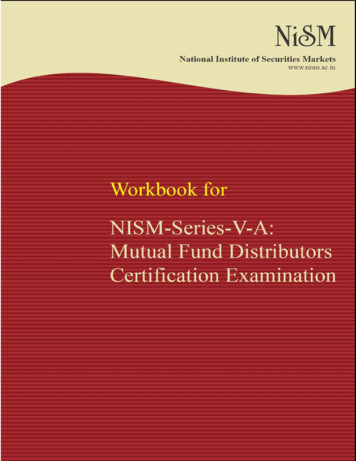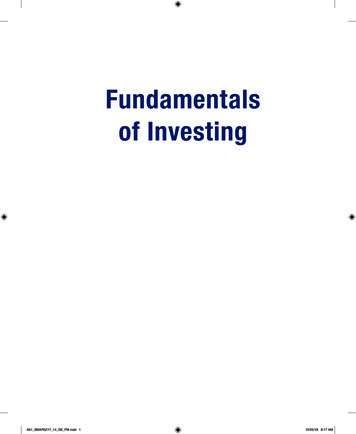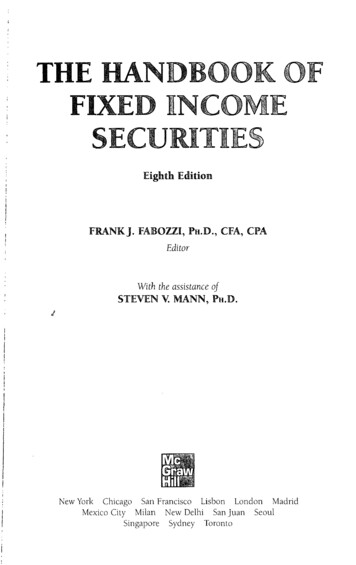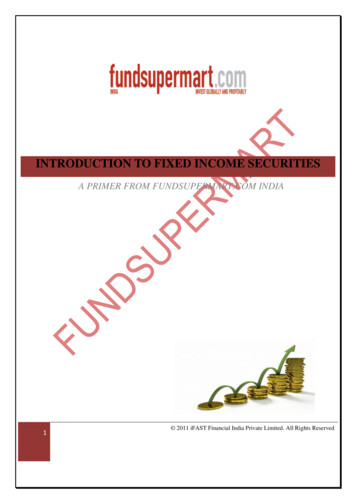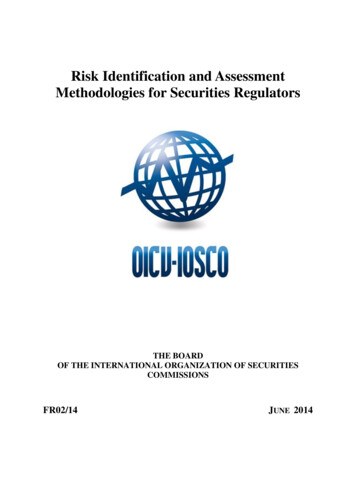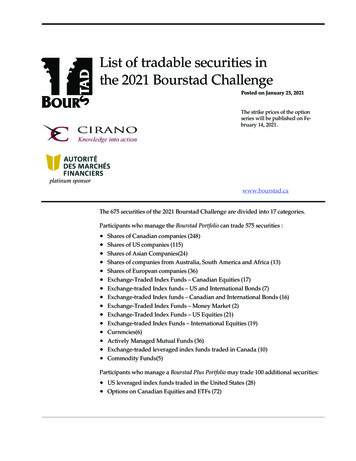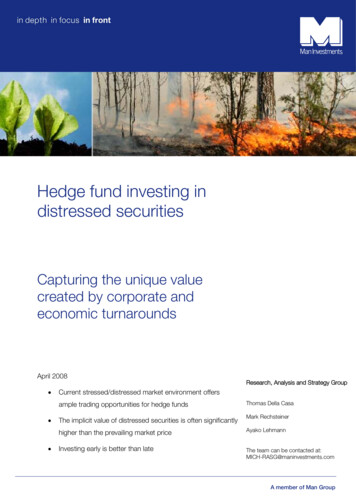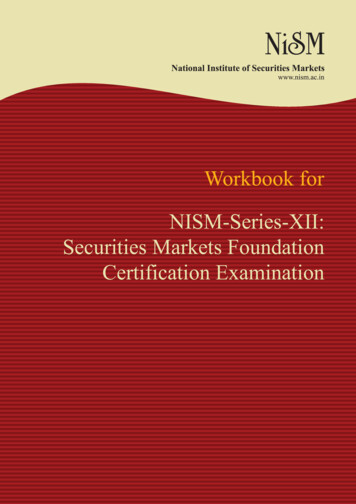
Transcription
NISM-Series-XII:Securities Markets FoundationCertification Examination
Workbook forNISM‐Series‐XII: Securities Markets FoundationCertification ExaminationNational Institute of Securities Marketswww.nism.ac.in1
NISM-Series-XII: Securities Markets Foundation Certification ExaminationThis workbook has been developed to assist candidates in preparing for the National Instituteof Securities Markets (NISM) Certification Examination for Securities Markets Foundation.Workbook Version: December 2016Published by:National Institute of Securities Markets National Institute of Securities Markets, 2016Plot 82, Sector 17, VashiNavi Mumbai – 400 703, IndiaAll rights reserved. Reproduction of this publication in any form without prior permission of thepublishers is strictly prohibited.2
NISM-Series-XII: Securities Markets Foundation Certification ExaminationForewordNISM is a leading provider of high end professional education, certifications, training andresearch in financial markets. NISM engages in capacity building among stakeholders in thesecurities markets through professional education, financial literacy, enhancing governancestandards and fostering policy research. NISM works closely with all financial sector regulatorsin the area of financial education.NISM Certification programs aim to enhance the quality and standards of professionalsemployed in various segments of the financial services sector. NISM’s School for Certification ofIntermediaries (SCI) develops and conducts certification examinations and ContinuingProfessional Education (CPE) programs that aim to ensure that professionals meet the definedminimum common knowledge benchmark for various critical market functions.NISM certification examinations and educational programs cater to different segments ofintermediaries focusing on varied product lines and functional areas. NISM Certifications haveestablished knowledge benchmarks for various market products and functions such as Equities,Mutual Funds, Derivatives, Compliance, Operations, Advisory and Research.NISM certification examinations and training programs provide a structured learning plan andcareer path to students and job aspirants who wish to make a professional career in theSecurities markets. Till May 2016, NISM has certified nearly 5 lakh individuals through itsCertification Examinations and CPE Programs.NISM supports candidates by providing lucid and focused workbooks that assist them inunderstanding the subject and preparing for NISM Examinations. The book covers all importanttopics to impart basic knowledge of the Indian securities markets to the participants and therelated rules and regulations. These include the basics of the Indian Securities Markets,processes involved in Primary and Secondary Markets and the schemes and products in MutualFunds and Derivatives Markets in India. The book also covers the essential steps in financialplanning process. It will be immensely useful to all those who want to learn about the variousaspects of securities markets.Sandip GhoseDirector3
NISM-Series-XII: Securities Markets Foundation Certification ExaminationDisclaimerThe contents of this publication do not necessarily constitute or imply its endorsement,recommendation, or favoring by the National Institute of Securities Markets (NISM) or theSecurities and Exchange Board of India (SEBI). This publication is meant for general reading andeducational purpose only.The statements/explanations/concepts are of general nature and may not have taken intoaccount the particular objective/ move/ aim/ need/ circumstances of individual user/ reader/organization/ institute. Thus NISM and SEBI do not assume any responsibility for any wrongmove or action taken based on the information available in this publication.Therefore before acting on or following the steps suggested on any theme or before followingany recommendation given in this publication user/reader should consider/seek professionaladvice.The publication contains information, statements, opinions, statistics and materials that havebeen obtained from sources believed to be reliable and the publishers of this title have madebest efforts to avoid any errors. However, publishers of this material offer no guarantees andwarranties of any kind to the readers/users of the information contained in this publication.Since the work and research is still going on in all these knowledge streams, NISM and SEBI donot warrant the totality and absolute accuracy, adequacy or completeness of this informationand material and expressly disclaim any liability for errors or omissions in this information andmaterial herein. NISM and SEBI do not accept any legal liability what so ever based on anyinformation contained herein.While the NISM Certification examination will be largely based on material in this workbook,NISM does not guarantee that all questions in the examination will be from material coveredherein.AcknowledgementThis workbook has been developed by NISM in cooperation with the Examination Committeefor NISM‐Series‐XII: Securities Markets Foundation Certification Examination consisting ofrepresentatives of Association of Mutual Funds in India (AMFI), BSE Ltd., Metropolitan StockExchange of India Ltd (MSEI), National Stock Exchange (NSE) and United Stock Exchange (USE).NISM gratefully acknowledges the contribution of all committee members.About the AuthorThis workbook has been developed by the Certification Team of National Institute of SecuritiesMarkets in co‐ordination with Ms. Uma Shashikant of the Centre for Investment Education andLearning. This workbook has been reviewed by Ms. Sunita Abraham, Consultant.4
NISM-Series-XII: Securities Markets Foundation Certification ExaminationAbout NISMNational Institute of Securities Markets (NISM) was established by the Securities and ExchangeBoard of India (SEBI), in pursuance of the announcement made by the Finance Minister in hisBudget Speech in February 2005.SEBI, by establishing NISM, articulated the desire expressed by the Government of India topromote securities market education and research.Towards accomplishing the desire of Government of India and vision of SEBI, NISM deliversfinancial and securities education at various levels and across various segments in India andabroad. To implement its objectives, NISM has established six distinct schools to cater to theeducational needs of various constituencies such as investors, issuers, intermediaries,regulatory staff, policy makers, academia and future professionals of securities markets.NISM is mandated to implement Certification Examinations for professionals employed invarious segments of the Indian securities markets.NISM also conducts numerous training programs and brings out various publications onsecurities markets with a view to enhance knowledge levels of participants in the securitiesindustry.About NISM CertificationsThe School for Certification of Intermediaries (SCI) at NISM is engaged in developing andadministering Certification Examinations and CPE Programs for professionals employed invarious segments of the Indian securities markets. These Certifications and CPE Programs arebeing developed and administered by NISM as mandated under Securities and Exchange Boardof India (Certification of Associated Persons in the Securities Markets) Regulations, 2007.The skills, expertise and ethics of professionals in the securities markets are crucial in providingeffective intermediation to investors and in increasing the investor confidence in marketsystems and processes. The School for Certification of Intermediaries (SCI) seeks to ensure thatmarket intermediaries meet defined minimum common benchmark of required functionalknowledge through Certification Examinations and Continuing Professional EducationProgrammes on Mutual Funds, Equities, Derivatives Securities Operations, Compliance,Research Analysis, Investment Advice and many more.Certification creates quality market professionals and catalyzes greater investor participation inthe markets. Certification also provides structured career paths to students and job aspirants inthe securities markets.5
NISM-Series-XII: Securities Markets Foundation Certification ExaminationAbout the WorkbookThis workbook has been developed to assist candidates in preparing for the National Instituteof Securities Markets (NISM) Certification Examination for Securities Markets Foundation.NISM‐Series‐XII: Securities Markets Foundation Certification Examination is for entry levelprofessionals, who wish to make a career in the securities markets.The book covers all important topics to impart basic knowledge of the Indian securities marketsto the participants and the related rules and regulations. These include the basics of the IndianSecurities Markets, processes involved in Primary and Secondary Markets and the schemes andproducts in Mutual Funds and Derivatives Markets in India. The book also covers the essentialsteps in financial planning process.6
NISM-Series-XII: Securities Markets Foundation Certification ExaminationAbout the Certification Examination for Securities Markets FoundationThis examination is a voluntary examination.The NISM‐Series‐XII: Securities Markets Foundation Certification Examination is for entry levelprofessionals, who wish to make a career in the securities markets. This certificationexamination will also be useful to all those individuals who are interested in acquiring a basicknowledge of the Indian Securities markets, including: Entry level professionals in the securities marketsEmployees of intermediaries functioning in the securities industryProfessionals in other industries interested in gaining knowledge of the securities marketsStudentsHomemakersTeachersThe purpose of this exam is to impart basic knowledge of the Indian securities markets to theparticipants and related rules and regulations.Examination ObjectivesOn successful completion of the examination, the candidate should: Know the basics of the Indian Securities Markets.Know the various processes involved in Primary and Secondary MarketsUnderstand the schemes and products in Mutual Funds and Derivatives Markets in India.Know the steps in financial planning process.Assessment StructureThe examination consists of 100 questions of 1 mark each and should be completed in 2 hours.The passing score on the examination is 60%. There shall be no negative marking.How to register and take the examinationTo find out more and register for the examination please visit www.nism.ac.in7
NISM-Series-XII: Securities Markets Foundation Certification ExaminationCONTENTSCHAPTER 1: UNDERSTANDING SECURITIES MARKETS AND PERFORMANCE . 111.1. Securities: Definition and Features . 111.2. Security Markets: Structure and Participants . 141.3. Role of Securities Markets as Allocators of Capital. 22CHAPTER 2: SECURITIES: TYPES, FEATURES AND CONCEPTS . 272.1. Equity and Debt Securities . 272.2. Features of Equity Capital . 282.3. Features of Debt Capital . 302.4. Choice between Equity and Debt . 312.5. Investing in Equity . 322.6. Equity Analysis and Valuation . 342.7. Commonly Used Terms in Equity Investing. 362.8. Risk and Return from Investing in Equity . 382.9. Basic Features of a Debt Instrument . 392.10. Types and Structures of Debt Instruments . 402.11. Concepts and Terms Relating to Debt Securities . 462.12. Benefits and Risks of Investing in Debt Securities . 492.13. Choosing between Debt and Equity . 512.14. Hybrid Instruments . 52CHAPTER 3: PRIMARY MARKETS . 613.1. Primary Market: Definition and Functions . 613.2. Types of Issues . 643.3. Issuers . 653.4. Regulatory Framework for Primary Markets . 673.5. Types of Investors . 713.6. Types of Public Issue of Equity Shares . 723.7. Pricing a Public Issue of Shares . 743.8. Public Issue Process. 753.9. Prospectus . 783.10. Applying to a Public Issue . 798
NISM-Series-XII: Securities Markets Foundation Certification Examination3.11. Listing of Shares . 823.12. Rights Issue of Shares . 823.13. Public Issue of Debt Securities . 833.14. Private Placements in Equity and Debt . 85CHAPTER 4: SECONDARY MARKETS . 914.1. Role and Function of the Secondary Market . 914.2. Market Structure and Participants . 934.3. Brokers and Client Acquisition . 964.4. Trade Execution. 1004.5. Settlement of Trades . 1094.6. Market Information and Regulation . 1164.7. Risk Management Systems . 1204.8. Rights, Obligations and Grievance Redressal . 122CHAPTER 5: MUTUAL FUNDS .1275.1. Meaning and Description of a Mutual Fund . 1275.2. Terms and Concepts Related to Mutual Funds . 1295.3. Working of a Mutual Fund . 1345.4. Regulation of Mutual Funds . 1365.5. Types of Mutual Fund Products . 1375.6. Processes for Investing in Mutual Funds . 1455.7. Systematic Transactions . 1495.8. Reading Mutual Fund Information . 1525.9. Benefits and Costs of Investing in Mutual Funds . 152CHAPTER 6: DERIVATIVE MARKETS .1576.1. Definition of Derivatives . 1576.2. Concepts of Underlying Derivatives . 1606.3. Types of Derivative Products . 1616.4. Structure of Derivative Markets. 1646.5. Trading and Settlement Process: Equity Futures . 1676.6. Risk Management in Derivative Markets . 1716.7. Costs, Benefits and Risks of Derivatives . 1746.8. Market Indicators . 1759
NISM-Series-XII: Securities Markets Foundation Certification ExaminationCHAPTER 7: FINANCIAL PLANNING AND SECURITIES MARKETS.1817.1. Overview of Financial Planning . 1817.2. Steps in Financial Planning . 1847.3. Asset Allocation and Diversification . 1897.4. Investing for Financial Planning . 190Glossary of Financial Terms .19510
NISM-Series-XII: Securities Markets Foundation Certification ExaminationCHAPTER 1: UNDERSTANDING SECURITIES MARKETS AND PERFORMANCELEARNING OBJECTIVES:After studying this chapter, you should know about: Securities market and the definition of securities Structure of securities market and its participants Role of securities markets in allocation of capital1.1.Securities Markets and Securities: Definition and FeaturesFinancial market consists of various types of markets (money market, debt market, securitiesmarket); investors (buyers of securities), issuers of securities (users of funds), intermediariesand regulatory bodies (SEBI, RBI etc.). The components of the Indian financial market can beillustrated through Figure 1. In this book, the focus will be on the securities markets.Figure: 1 Components of Indian Financial MarketsThe securities markets provide a regulated institutional framework for an efficient flow ofcapital (equity and debt) from investors to business in the financial market system. It provides a11
NISM-Series-XII: Securities Markets Foundation Certification Examinationchannel for allocation of savings to investments. Thus, the savings of households, business firmsand government can be channelized through the medium of securities market to fund thecapital requirements of a business enterprise.Savings are linked to investments by a variety of intermediaries through a range of complexfinancial products called “securities”. Securities are financial instruments issued by companies,financial institutions or the government to raise funds. These securities are purchased byinvestors who in turn convert their savings into financial assets.The term “securities” has been defined in Section 2 (h) of the Securities Contracts (Regulation)Act 1956. The Act defines securities to include:a)shares, scrips, stocks, bonds, debentures, debenture stock or other marketablesecurities of a like nature in or of any incorporated company or other body corporate;b)derivative;c)units or any other instrument issued by any collective investment scheme to theinvestors in such schemes;d)security receipt as defined in clause (zg) of section 2 of the Securitisation andReconstruction of Financial Assets and Enforcement of Security Interest Act, 2002;e)units or any other such instrument issued to the investors under any mutual fundscheme (securities do not include any unit linked insurance policy or scrips or any suchinstrument or unit, by whatever name called which provides a combined benefit risk onthe life of the persons and investment by such persons and issued by an insurer refer toin clause (9) of section 2 of the Insurance Act, 1938 (4 of 1938));f)any certificate or instrument (by whatever name called), issued to an investor by anyissuer being a special purpose distinct entity which possesses any debt or receivable,including mortgage debt, assigned to such entity, and acknowledging beneficial interestof such investor in such debt or receivable, including mortgage debt, as the case maybe;g)government securities;h)such other instruments as may be declared by the Central Government to be securities(including onshore rupee bonds issued by multilateral institutions like the AsianDevelopment Bank and the International Finance Corporation);i)rights or interest in securities.Features of Securities: A security represents the terms of exchange of money between two parties. Securities areissued by companies, financial institutions or the government and are purchased by12
NISM-Series-XII: Securities Markets Foundation Certification Examination investors who have the money to invest. The broader universe of savers with surplus toinvest is available to the issuers of securities; a universe of wider options is available tosavers to invest their money in.Security issuance allows borrowers to raise money at a reasonable cost while securityownership allows investors to convert their savings into financial assets which provide areturn. Thus, the objectives of the issuer and the investor are complementary, and thesecurities market provides a platform to mutually satisfy their goals.The business enterprises issues securities to raise money from the entity with surplus fundsthrough a regulated contract. The enterprise list these securities on a stock exchange toensure that the security is liquid (can be sold when needed) and provides information aboutits activities and financial performance to the investing entity.The issuer of the security provides the terms on which the capital is being raised.The investor in the security has a claim to the rights represented by the securities. Theserights may involve ownership, participation in management or claims on assets.Securities can be broadly classified into equity and debt. The terms of issue, rights ofinvestors, risk and return for these two classes of securities varies widely. Return refers tothe benefits that the investor will receive from investing in the security. Risk refers to thepossibility that the expected returns may not materialise. For example, a company may seekcapital from an investor by issuing a bond. A bond is a debt security, which means itrepresents a borrowing of the company. The security will be issued for a specific period, atthe end of which the amount borrowed will be repaid to the investor. The return will be inthe form of interest, paid periodically to the investor, at a rate and frequency specified inthe security. The risk is that the company may fall into bad times and default on thepayment of interest or return of principal.An investor has the right to seek information about the securities in which he invests. Forexample, when investors buy the bond, they can seek information about the company, askfor evaluation of its ability to repay the borrowed amount, seek the rights to claim theirdues if the company shuts down, and also have the benefit of a liquid market in which theycan sell off the security if they do not like to bear the risks. Thus, the institutional structureof securities markets enables assuming risks in exchange for returns, evaluating the risksand return based on information available about the security, and transferring of risk whenthe investor sells the security to another investor who may be willing to bear the risk, forthe expected return.Those who need money can source it from those who have it primarily through two means:a. A one‐to‐one transaction, whose terms are determined and agreed to mutuallyb. A standard security, whose terms are accepted by both parties13
NISM-Series-XII: Securities Markets Foundation Certification ExaminationWhat is the difference between these two choices? Assume that a bank accepts a 3‐yeardeposit from a customer. This is a transaction between the bank and its customer. The bank hasborrowed the money; the customer has lent the money. The bank will repay the deposit only tothe customer. The interest rate is fixed when the deposit is accepted. The deposit has to bekept for a 3‐year period. If the customer needs money earlier than that, the deposit can bebroken but may be subject to penalties. The bank may issue a fixed deposit receipt to thecustomer, but that receipt is not transferable.Assume instead that the bank issues a certificate of deposit (CD), which is a security. The CD isalso for 3‐years and carries the same interest rate as the deposit. But the similarities end there.The customer can hold the CD for any period he wishes, and then transfer it to anothercustomer. The investor who holds the CD on the date of its maturity submits it to the bank andcollects the maturity value. When the CD transfers form one investor to another, the price isdetermined based on what both agree as the market rate at that time.When a monetary transaction between two parties is structured using a security, the flexibilityto both parties is higher. Bank deposits, inter‐corporate deposits, company fixed deposits,deposits with housing finance and other finance companies, chit funds and benefit funds are allnot securities. Insurance policies are also contracts and are not securities. Investment inprovident funds or pension funds is also not investment in securities. All these are financialarrangements between two parties that are not in the form of transferable securities.1.2.Security Markets: Structure and ParticipantsStructureThe market in which securities are issued, purchased by investors, and subsequentlytransferred among investors is called the securities market. The securities market has twointerdependent and inseparable segments, viz., the primary market and the secondary market.The primary market, also called the new issue market, is where issuers raise capital by issuingsecurities to investors. The secondary market, also called the stock/securities exchange,facilitates trade in already‐issued securities, thereby enabling investors to exit from aninvestment. The risk in a security investment is transferred from one investor (seller) to another(buyer) in the secondary markets. Thus, the primary market creates financial assets, and thesecondary market makes them marketable.ParticipantsInvestors and issuers are the main building blocks of a securities market. Issuers supplysecurities and create a demand for capital; and investors buy the securities and thereby provide14
NISM-Series-XII: Securities Markets Foundation Certification Examinationthe supply of capital. Interaction between investors and borrowers is facilitated throughfinancial intermediaries who are the third component of the market. The entire process ofissuance, subscription and transaction in securities is subject to regulatory control andsupervision.There are se
Till May 2016, NISM has certified nearly 5 lakh individuals through its Certification Examinations and CPE Programs. NISM supports candidates by providing lucid and focused workbooks that assist them in understanding the subject and preparing for NISM Examinations. The book covers all important
